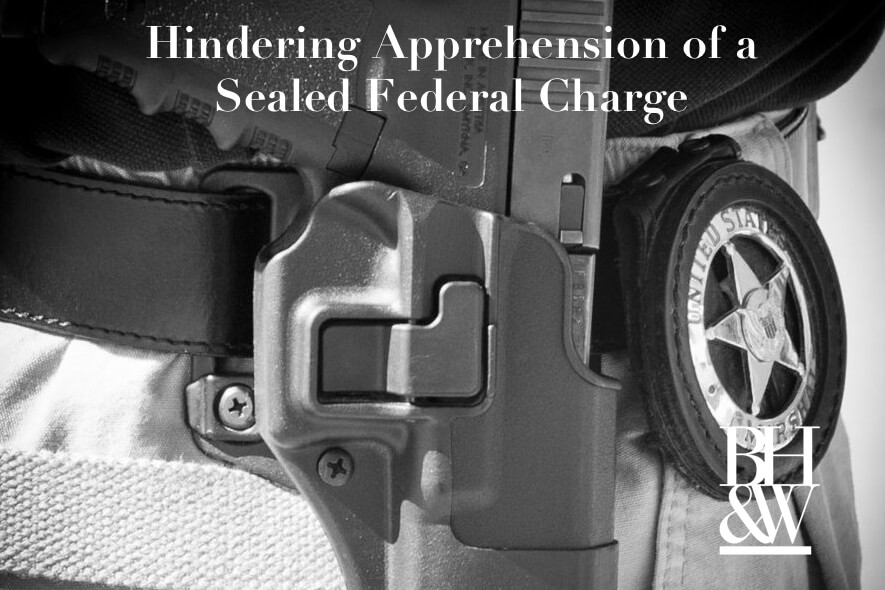
“Run, Baby, Run!” Girlfriend’s Warnings, Personal Tattoos, and Attempts to Flee From US Marshals, Do Not Rise to the Level of “Felony Hindering Apprehension” Says the CCA
 Keiona Nowlin and her boyfriend, Demarcus Degrate, were riding in a car when a United States Marshal, executing a sealed, federal warrant on the boyfriend, pulled up behind them. After the Marshal activated the siren and lights, the couple pulled over and Degrate fled on foot. The Marshal chased Degrate. Moments later, as two Marshals arrived at the scene, they observed Nowlin screaming, “Run baby run…get away” while she also fled on foot. The Marshals detained Nowlin “to find out why she was running.” At that point, Nowlin fled the Marshals’ car. Nowlin was placed under arrest for escape.
Keiona Nowlin and her boyfriend, Demarcus Degrate, were riding in a car when a United States Marshal, executing a sealed, federal warrant on the boyfriend, pulled up behind them. After the Marshal activated the siren and lights, the couple pulled over and Degrate fled on foot. The Marshal chased Degrate. Moments later, as two Marshals arrived at the scene, they observed Nowlin screaming, “Run baby run…get away” while she also fled on foot. The Marshals detained Nowlin “to find out why she was running.” At that point, Nowlin fled the Marshals’ car. Nowlin was placed under arrest for escape.
See the CCA Opinion in Nowlin v. State.
After the arrest, Nowlin said she “knew the cars the Marshals drove…and…did not want Degrate to be arrested…[because] he was out on bond for state charges.” The Marshal noted that Nowlin had Degrate’s name tattooed near her collarbone; the trial court inferred the tattoo as indicative of an intimate relationship. The trial court found Nowlin guilty of third-degree felony hindering apprehension, sentencing her to four years imprisonment.
Nowlin appealed to the court of appeals, arguing that she was not warning Degrate of impending apprehension because “he was already aware of the [Marshal’s] presence.” Nowlin contended that because she did not know the contents of the sealed federal warrant, she could not have known Degrate was charged with a felony. The court of appeals disagreed, holding that her statement at the scene, “run baby run…get away,” provided sufficient evidence of providing a warning to Degrate. The court of appeals pointed to statements made at the scene that she knew “he was out on bond for state charges…and…she did not want her man to get arrested.” The court of appeals added that her tattoo was proof of her close relationship with Degrate, and that she likely knew of the felony-level charges he was facing.
Nowlin appealed to the Court of Criminal Appeals, arguing that because the federal indictment was sealed and secret, she could not have known about the indictment itself; that no evidence exists that she knew of the felony-level charges Degrate faced; and, that her tattoo was not proof of a close relationship where she would have had knowledge of the charges. The State argues that the evidence was sufficient: that the tattoo is evidence of a close relationship that implies she knew intimate details of Degrate’s life; that she knew Degrate faced serious state-level charges, and that her attempt to flee from the US Marshal is evidence of her knowledge of the “serious nature of Degrate’s crimes.” In an interesting turn of events, the State offered an alternative to acquittal–that an alternative charge could be misdemeanor-level hindering apprehension, and the sentence could be amended to reflect a lesser charge.
“In order to show that the evidence presented was legally sufficient to support a conviction of felony hindering apprehension, the State must prove:
- the defendant warned another person of impending discovery or apprehension;
- the defendant had the intent to hinder that individual’s arrest; and,
- the defendant had knowledge that the individual was under arrest for, charged with, or convicted of a felony.
Tex.Penal Code § 38.05(a), (d).
An individual acts with knowledge when he is aware that the circumstances exist. Tex. Penal Code § 6.03(b). In a nutshell, the State must show Nowlin was aware that her boyfriend was under arrest for, charged with, or convicted of a felony. The Court of Criminal Appeals (“CCA”) now decides whether the evidence is sufficient to show that Nowlin knew Degrate was charged with a felony offense.
Here, the CCA does not agree with the trial court and court of appeals. “The state offense that Degrate was on bond for cannot serve as the basis for [Nowlin’s] conviction.” The CCA notes that there was no evidence at trial that named the type and level of the state offense, therefore, the trial court had no way of knowing if the offense was a felony or not. Also, there was no mention of whether Nowlin knew what type of charge her boyfriend was facing. Therefore, because there was insufficient evidence regarding the state offense, the state offense cannot serve as the basis for Nowlin’s conviction.
Further, Degrate’s federal indictment was sealed. There was no way for Nowlin and Degrate to know about the charges before their arrests. “With this mandated secrecy and the lack of evidence that he was told about the indictment during the attempt to arrest him, Degrate could not have known that he was under indictment for felon in possession of a firearm.” It would have been impossible for Degrate to have told Nowlin about the felony charge because he would not have known about it.
Lastly, the inferences made about Nowlin’s close relationship with Degrate—including the tattoo on her collarbone and her attempt to escape the Marshall—do not apply here. “While the inferences that the court of appeals makes would likely be reasonable ones had there been any evidence of Degrate himself having knowledge of the indictment, no such evidence was ever presented.”
The CCA found that the evidence was insufficient to support a felony-level hindering apprehension charge. The CCA reforms Nowlin’s convictions to a misdemeanor hindering apprehension charge, instructing the trial court to conduct a new punishment hearing to reflect the lesser charge.


 Here’s a Breaking Bad question for you: If Walt lets Jesse cook a batch of Meth and Jesse screws it up, such that it is unsellable, can they be punished for the amount of bad methamphetamine that they cooked in addition to the amount of good methamphetamine (if there were such a thing)? This 5th Circuit tells us in United States v. Ramirez-Olvera.
Here’s a Breaking Bad question for you: If Walt lets Jesse cook a batch of Meth and Jesse screws it up, such that it is unsellable, can they be punished for the amount of bad methamphetamine that they cooked in addition to the amount of good methamphetamine (if there were such a thing)? This 5th Circuit tells us in United States v. Ramirez-Olvera.
 A federal agent saw Appellant walk out of a house under surveillance as part of a
A federal agent saw Appellant walk out of a house under surveillance as part of a 
 New Case from the 5th Circuit (Federal):
New Case from the 5th Circuit (Federal): 






